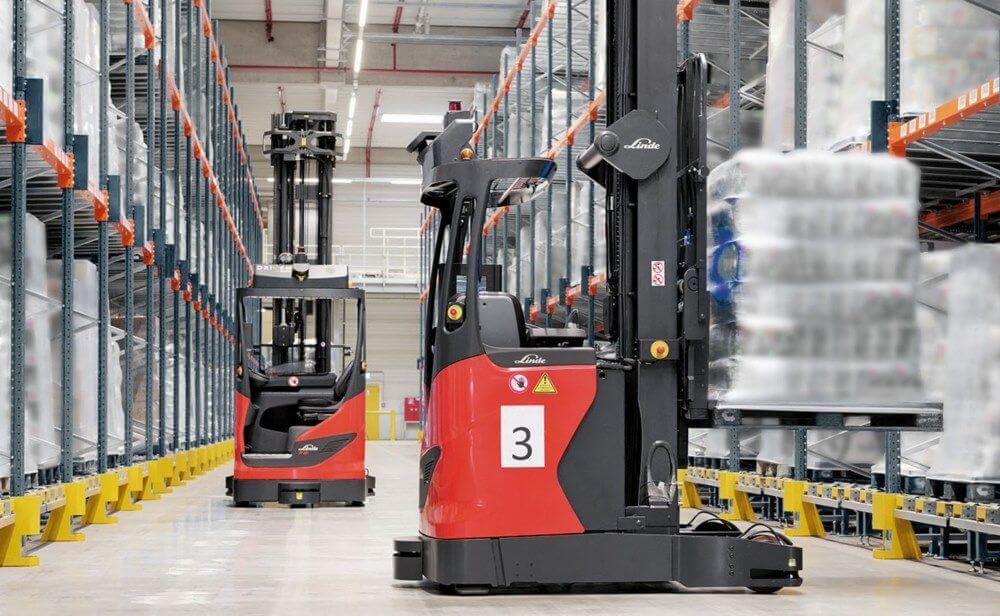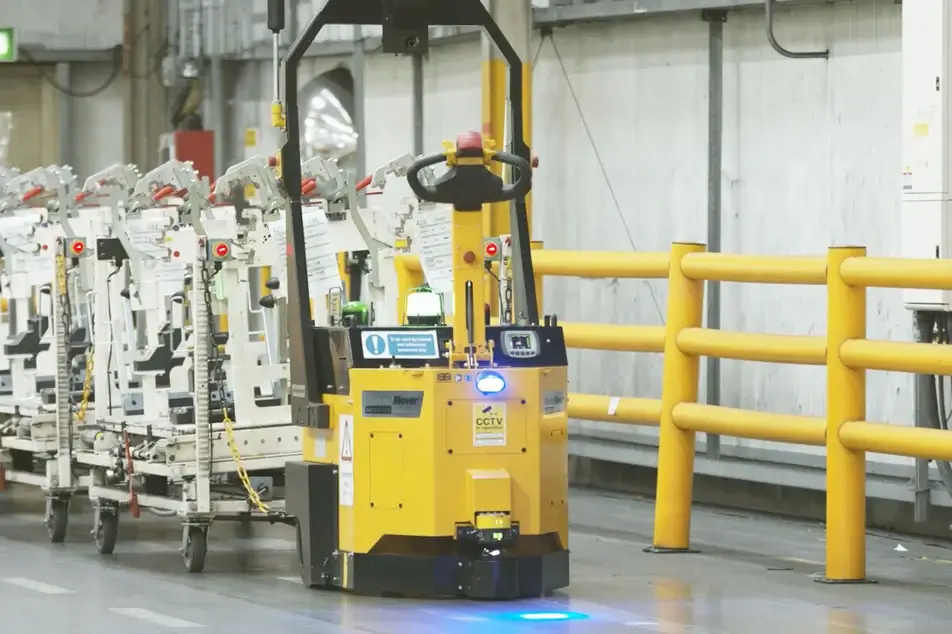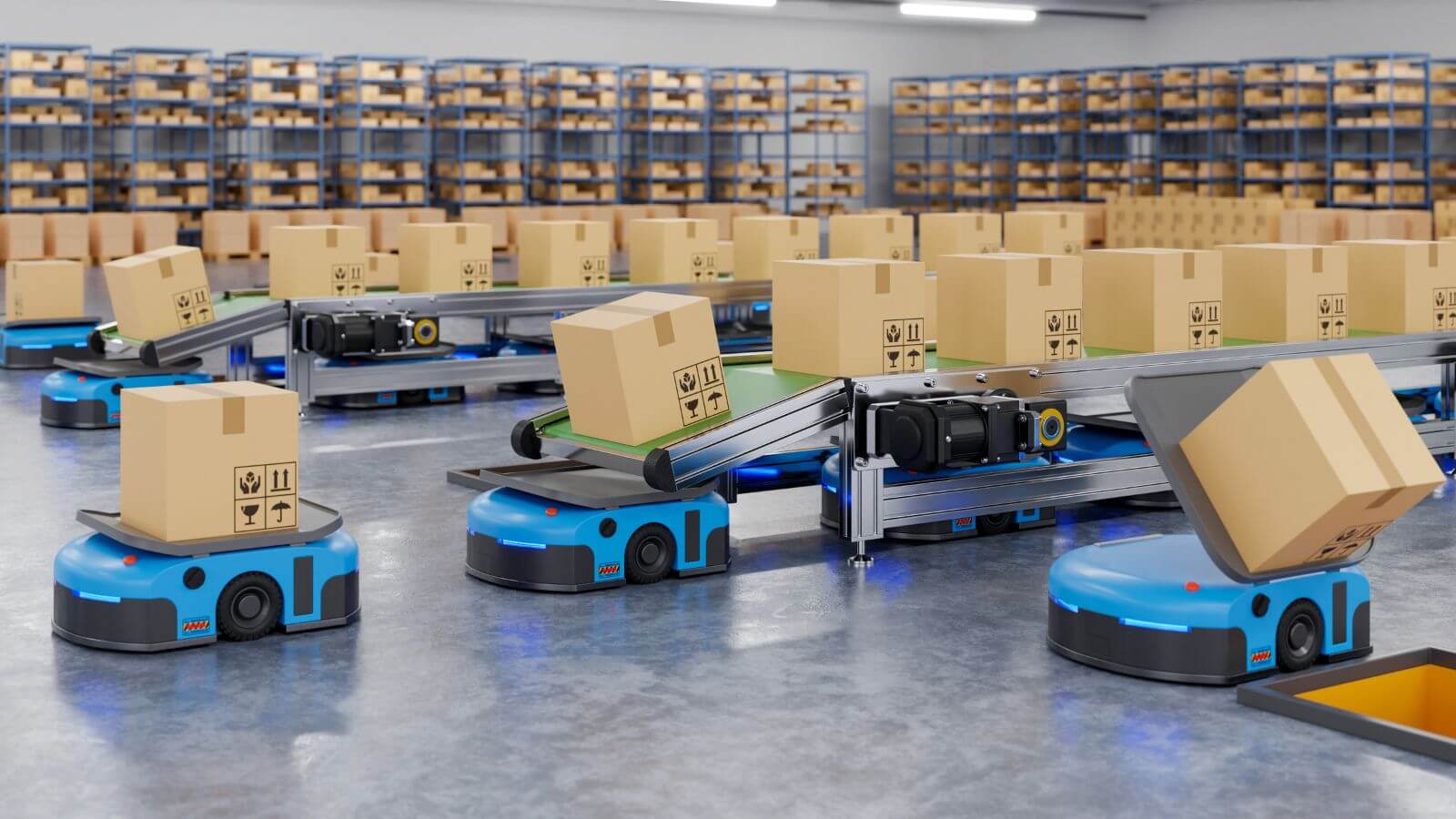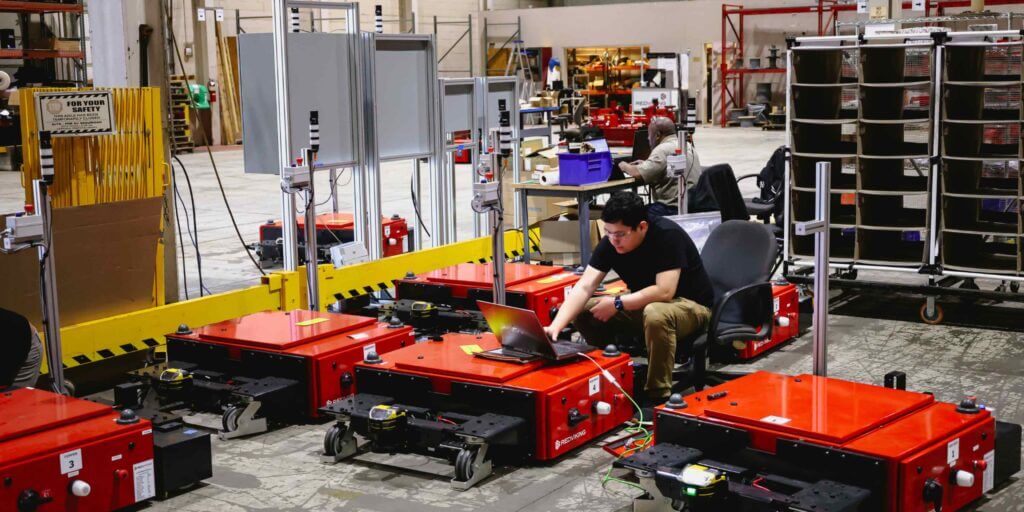AGV là gì? Giải đáp tất cả về robot tự hành AGV trong sản xuất
An Automated Guided Vehicle (AGV) system, also referred to as autonomous guided vehicles, self-guided vehicles or mobile robots, are material handling systems that transport goods or materials within a controlled environment without the need for a human operator or driver.
They are often employed in manufacturing facilities, warehouses, or distribution centers. An AGV can take on any form a customer requires to best address their application needs.

5 Types of Automated Guided Vehicles (AGVs)
Automated Guided Carts (AGCs)
An automatic guided cart (AGC) is the most basic type of AGV with minimal features. Navigation systems can range from systems as simple as magnetic tape to complex, sensor-based navigation systems that use AI to navigate their environment.
They are often used for transporting smaller loads or items within a facility, such as components or parts on assembly lines, or for carrying tools, waste, and equipment.
Other use cases include:
- Sorting and storage applications
- Cross-docking operations
- Automated hospital cart transporters for meals, linens, waste, and supplies
Forklift AGVs

Forklift AGVs are designed to mimic the functionalities of conventional forklift trucks, but without the need for a human operator. They have forks to lift and place loads at various heights. Forklift AGVs are widely used in warehouses and manufacturing facilities for tasks such as stacking pallets, retrieving items from racks, and loading/unloading trucks. Some forklift AGV use cases include:
- Warehouse operations for stacking and retrieving goods
- Production environments for supplying raw materials to production lines
- Distribution centers for loading and unloading goods
Unit Load AGVs
These AGVs are designed to transport individual unit loads, such as pallets, containers, or racks. They often have platforms or forks to support and move the loads. Unit load AGVs are commonly used in warehousing, distribution centers, and manufacturing facilities for tasks such as:
- Pallet movement
- Loading/unloading, and storage
Towing AGVs (Tuggers)
Towing AGVs, or tuggers, are used to pull or tow carts, trailers, or other wheeled devices autonomously, almost like a train. They are equipped with a hitch or coupling mechanism to connect and transport loads. Tow AGVs are often used in applications where multiple smaller loads need to be moved simultaneously, such as delivering materials to production lines.

Compared with AGCs, tugger AGVs have greater throughput because they can transport many carts in the same mission. This type of AGV is suitable for:
- Moving multiple small loads simultaneously
- Delivering materials to production lines.
Heavy Burden Carriers
For the heaviest industrial applications, heavy burden carriers are AGVs equipped to handle:
- Large assembly components
- Heavy casting and coil
- Plate transport in industries such as steel manufacturing and heavy machinery assembly
Some models feature self-loading capabilities and advanced steering options (standard, pivot, or omni-directional) to navigate through tight spaces and complex industrial environments.
How AGVs Work & Key Features of AGVs
AGVs are designed to follow pre-defined paths or guidance systems within a facility. These paths can be determined by physical means such as magnetic tape, wires, or optical lines, or through more sophisticated methods like laser navigation using pre-installed reflectors.
Navigation and Guidance
AGVs navigate through environments using various guidance technologies, including:
- Magnetic Tape or Wire: AGVs follow a path defined by magnetic tape or a wire embedded in the floor. The vehicle detects the magnetic field or electrical signal to follow the predetermined route.
- Laser Navigation: AGVs equipped with laser navigation use reflectors placed around the facility. The AGV emits laser beams that bounce off these reflectors, and the vehicle calculates its position based on the time it takes for the light to return.
- Optical Navigation: This method involves AGVs following visual markers or lines painted on the floor.
- Inertial Navigation: AGVs use gyroscopes and accelerometers to track their movement from a known position, allowing them to navigate based on calculated changes in position over time.
- GPS Navigation: In outdoor applications, AGVs can use GPS for navigation, although this is less common in indoor settings due to limited satellite signal reception.
AGV steering
AGV steering is controlled by differential speed control, steered wheel control or a combination of the two:
- Differential speed control: This is the most common type of steering control used by AGVs. Differential speed control uses two independent drive wheels. Each drive wheel is driven at a different speed to turn. To go forward or backwards, the two drives are driven at the same speed. The simplest steering control option for AGVs, differential speed control doesn’t require additional steering motors or mechanisms. It is commonly used for AGVs that operate in tight spaces or for those that operate near machines. It is not used for towing applications, as it can cause a trailer to jackknife while turning.
- Steered wheel control: This type of steering control is similar to the steering control in a car or truck. In steered wheel control, the drive wheel is the turning wheel. Steered wheel control is more precise than differential speed control and offers smoother turning. It is often used for towing applications and may also be operator-controlled.
- Combination steering: This is a combination of differential speed control and steered wheel control. AGVs using combination steering have two independent steer/drive motors on diagonal corners of the AGV and swiveling castors on the other two corners. AGVs using combination steering can turn in any direction like a car and also drive in differential steering mode in any direction.
Obstacle Detection and Safety
AGVs are equipped with sensors and safety mechanisms to detect obstacles and ensure safe operation. Common safety features include:
- Lidar and Ultrasonic Sensors: These sensors detect obstacles in the AGVs path and can trigger the vehicle to slow down or stop to avoid collisions.
- Bumpers: Physical bumpers may trigger an emergency stop if the AGV comes into contact with an object or person.
- Emergency Stop Buttons: Manual stop buttons allow humans to immediately stop the AGV if necessary.

Signal connection & Communication
AGVs are part of a larger automated system and communicate with a central control system to receive instructions and coordinate with other vehicles and systems. Communication can occur via:
- Wi-Fi: AGVs connect to a central control system through wireless networks to receive routing information and task assignments.
- RFID Tags: Radio-frequency identification tags embedded in the floor can provide location data to AGVs and trigger specific actions when detected.
AGV traffic control
Traffic control measures include zone control, collision avoidance or a mix of both:
- Zone control: Simple to install and easy to expand, zone control is a commonly used traffic control method for AGVs. A wireless transmitter transmits signals in defined areas, and the AGV contains a sensor that receives the signal and transmits it back to the transmitter. If the area is clear, a “clear” signal is sent that allows the AGV to enter or pass through the area. If another AGV is in the area, a “stop” signal is sent that alerts other AGVs attempting to enter that the area is not clear. In this case, the waiting AGVs will stop and wait until the first AGV moves out of the zone and a “clear” signal is sent by the transmitter. Another way zone control can be used is by equipping each AGV with its own transmitter, allowing it to send a “do not enter” signal to other AGVs approaching the zone.
- Collision avoidance: AGVs using collision avoidance zone control are equipped with sensors that transmit a signal and wait for a reply to determine if an object is in front of it. These sensors may be sonic, which work like radar, or optical, which uses infrared sensors. Both work in a similar manner. Bumper sensors are another type of collision avoidance sensor. Many AGVs are equipped with bumper sensors as a fail-safe. Bumper sensors stop to avoid a collision when they sense physical contact.
- Combination control: AGVs that use combination control are equipped with both collison control sensors and zone control sensors in order to offer more robust collision prevention in all situations. For instance, an AGV may use zone control as its primary traffic control system but also have collision avoidance sensors as a backup in case the zone control system malfunctions.
Advantages of AGVs
Reduced Labor Costs
AGVs can significantly lower the costs associated with manual labor by taking over repetitive and routine tasks. The initial investment in AGVs may be substantial, but over time, the reduction in expenses related to salaries, benefits, and potential human resource issues can lead to considerable savings.
Increased Safety
Equipped with advanced sensors and safety features, AGVs reduce the risk of workplace accidents. They can operate in environments that may be hazardous or challenging for human workers, such as extreme temperatures or areas with hazardous materials.

Increased Accuracy and Productivity
AGVs reduce the likelihood of errors associated with human fatigue or oversight. Their ability to operate continuously, without breaks or shifts, means they can significantly enhance productivity, ensuring a steady flow of operations round-the-clock.
Flexibility
Some AGVs offer the flexibility of easily changing routes (compared to others which require re-routing guide wires or other infrastructure to adjust a vehicle’s route). Automated guided vehicles are a scalable solution, as well, with the ability to add additional units based on demand.
Disadvantages of AGVs
Not Suitable for Non-repetitive Tasks
AGVs excel in controlled environments where tasks are consistent and repetitive. In operations where tasks vary widely or require human judgment, AGVs may not be as effective, limiting their applicability to certain types of work.
Reliance on dust sensitive sensors
AGVs rely on sensors, cameras, and other navigation technologies to move and perform tasks within their operating environments. Dust and particulate matter can interfere with these systems, potentially leading to operational inefficiencies and downtime.
For instance, dust accumulation on sensors may reduce their accuracy or block their function entirely, requiring regular cleaning and maintenance to ensure optimal performance.
Increased space requirements for warehousing
In comparison to other automated storage and retrieval (AS/RS) solutions like cube storage systems, AGVs require wider aisles to accommodate their movement and operational clearance. This increased footprint must be considered in the total cost of operation and can impact the overall warehouse design and efficiency. When compared with other automated technologies like conveyors however, AGVs are far more flexible and space-efficient.
High Initial Investment Costs
Although AGVs can reduce labor costs in the long term, the initial investment required to implement an AGV system can be quite substantial. This includes the costs associated with purchasing equipment, installing the system, and developing the necessary infrastructure. For small businesses or startups, this investment can pose a significant barrier.
Time Required for Fine-tuning and Maintenance
AGVs require a complex setup and fine-tuning process to operate effectively within a specific environment. This may involve programming routes, conducting regular maintenance, and making adjustments when there are changes in the workplace or production processes. The time and resources needed for these tasks can lead to operational disruptions and increased operating costs.
Where are Automated Guided Vehicles used?
Industrial AGV systems are built for multiple industries, including automotive assembly, aerospace manufacturing, power generation, rail, food and steel processing, chemical, commercial printing, hospitals, paper mills, pharmaceuticals, plastics, and warehousing and distribution facilities. All of these industries require application-specific material handling equipment to realize an efficient operation.
AGVs are the perfect vehicle to improve on existing material handling processes through their absolute ability to seamlessly integrate into an existing operation, improving the overall processes, or to become the driving design factor in a new, efficient assembly design.
The Maintenance & Repair portion of many industries also employ AGV systems. From traversing heavy wheel-sets along the vast corridors of a rail maintenance facility to running parts for an aviation repair shop, AGVs are a very adaptable product when designed for specific application solutions.
